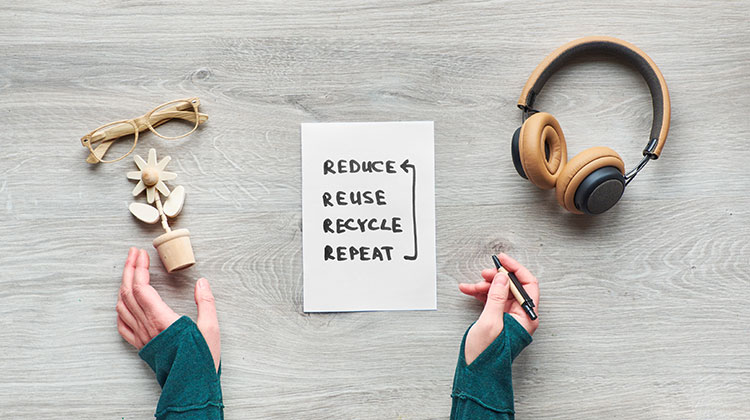What is the concept of ‘carbon footprint’, which was first partially pronounced in the early 1990s, and how can we minimize our individual carbon footprint? We have compiled the answers to all these questions for you.
“How big is your carbon footprint?” asks British Petroleum, the world’s second largest oil company with a total of 18,700 petrol and service stations in 2003, when the ad aired. This company, which prefers to approach the issue of climate change through personal impact and its measurement, is also responsible for the leakage of 49 million barrels of oil into the Gulf of Mexico, causing the biggest industrial disaster in history in 2010.
What is carbon footprint?
The carbon footprint is the amount of carbon dioxide emissions associated with all activities carried out by a person or legal entity such as a building, company, city. In other words, as a result of the choices we make, methane or carbon dioxide gases are released into the air; The carbon footprint corresponds to the sum of the amount of greenhouse gases released by these gases. This list of preferences extends from the food we eat to the grocery store we shop, from the gas and electricity we burn at home to the fossil fuels we use in our vehicles.
The concept is rooted in the concept of ecological footprint, invented early 1990s at the University of British Columbia by Canadian ecologist William Rees and Swedish-born regional planner Mathis Wackernagel. The ecological footprint was used with reference to the total land area and/or natural resource required to sustain an activity or community. It talked about environmental impacts, such as water use, space required for food production. In contrast, a carbon footprint is expressed in tons or units of weight, such as the annual amount of carbon dioxide.

Rather than the greenhouse gas emissions associated with production, the carbon footprint goes hand in hand with consumption. For products imported to a country, if the product was produced in another country, international transportation and transportation of the product are included in the emission calculation. As a result, while the carbon footprint in that country increases, the emission rate may well decrease. In fact, the rate of carbon dioxide produced by an average individual in a year is also determined on a country basis; It is calculated by dividing the total emissions of each country by the population. This gives rise to the criterion that rich countries with a high standard of living will have a high carbon footprint, and poor countries with a low standard of living will have a low carbon footprint.
Ethical-Clothing.com is have a great fashion calculator tool. They have 12 simple questions to help you really understand your fashion footprint. Visit their website and explore ethical and sustainable clothing.
In 2017, while the per capita measurement was 49 tons in Qatar, one of the Middle Eastern countries with a low population and the major oil production, it was 30 tons in Trinidad and Tobago, 25 tons in Kuwait, 25 tons in the United Arab Emirates, 24 tons in Brunei, It measured 23 tons in Bahrain and 19 tons in Saudi Arabia.
In developed countries with a high population and standard of living, there is a balance that justifies the equation; While carbon emissions per capita in Australia are 17 tons, it corresponds to 16.2 tons in the United States and 15.6 tons in Canada. These figures are almost three times higher than in 2017, when the average per capita was 4.8 tons.
In Europe, on the other hand, energy choices play a big role in the difference, even if the living standards are similar between countries. According to the measurements in 2015, only 6% of the electricity production in France was based on fossil fuels, while this rate was 55% in Germany. This explains why the amount of emissions per capita in France is 5.8 tons, while the amount in Germany is 8.56 tons.
Sub-Saharan Africa is home to the countries with the lowest amount of carbon emissions. With an average footprint of about 0.1 tonnes, these mostly poor countries are 160 times below the United States or Canada, and the average American or Canadian consumes in just 2.3 days the amount the average Malian or Nigerian consumes per year.
Our individual carbon footprint

The United Nations points to 2050 as the critical threshold for reducing individual carbon emissions by 2 tons at the individual level, in order to prevent a critical 2 degree rise in global air temperature. Because, thanks to the report of the UN’s Intergovernmental Panel on Climate Change (IPCC), it is no longer possible to prevent the temperature increase by 1.5 degrees compared to the pre-industrial period and the global temperature is 1.5 degrees Celsius by 2030, ten years earlier than predicted in 2018. We have recently faced the fact that it will increase. As such, yes, in order to see real progress, states and companies must make and implement radical decisions that will bring real change and transformation, but even small individual calculations will undoubtedly lead to big steps and collective action.
In developed countries, transportation and domestic energy use are the largest components of individual carbon footprints. For example, 40% of total emissions in America in the first decade of the 21st century come from these sources. These types of emissions over which individuals have direct control are referred to as individuals’ ‘primary’ carbon footprints. All of the remaining emissions related to the consumption of products and services are categorized as ‘secondary’ carbon footprints. The carbon footprint of food production falls into the secondary category. Meat and foods transported over long distances are included in this cluster, which requires more energy and resources to be consumed than the production of vegetables and grains.
The production and transportation of consumer products are also contributors to the secondary footprint. For example, the carbon footprint of a bottle of water itself includes the production of the bottle and its delivery to the consumer. If we are to elaborate on the factors and the area they cover; natural gas, petroleum, coal and other fuels 15%, holiday and entertainment 14%, electricity consumption 12%, activities in the public sphere 12%, individual vehicle use 10%, basic household goods 9%, vehicle manufacturing 7%, travel vehicle 6% , food and beverage consumption is 5%, clothing consumption is 4%, public transportation is 3% and financial movements are 3%.
How to reduce carbon footprint in daily life?

In your daily life, of course, you can’t reduce your entire carbon footprint to zero—unless you live in an unheated home or get all your nutrients from your garden. Yet taking the environmental responsibility of our own lives into our own hands is about our choices.
Still, it’s a good starting point to save as much energy as possible in your home. In the UK, household energy consumption accounts for 14% of the country’s total carbon emissions. You can make a habit of daily practices such as replacing your light bulbs with energy-saving LED ones, making sure that your appliances are turned off or unplugged when you are not using them, washing your clothes at low temperatures and not using a dryer.
You can reduce your carbon footprint by controlling your water consumption at home. You may remember that using the tub before taking a bath consumes more than 5 times more water than a shower. You can also save water by turning off the tap while brushing your teeth or shaving.
The share of the devices we use, the internet and the systems that feed them in the global greenhouse gas emission pie is about 3.7% and this rate is expected to double in 2025.
With the sudden decrease in the global demand for energy due to the restrictions, as of the beginning of the COVID-19 pandemic, carbon emissions decreased by 5.8% in 2020, although this figure increased by 5% in 2021, the last period of 2019, which saw the peak. managed to stay below 1.2%. And yet, the idea that staying at home reduces individual carbon footprints is unfortunately an illusion; because the share of the devices we use, the internet and the systems that feed them in the global greenhouse gas emission pie is about 3.7% and this rate is expected to double in 2025.
Being aware of the foods you consume is another topic where you can achieve success in reducing your carbon footprint. According to the UN, food production systems are responsible for one-third of global greenhouse gas emissions.
The UN also recommends reducing meat consumption at a similar point. So much so that even if renewable energy sources and electric vehicles become normalized, environmental damage from food production alone is a threat to the climate crisis. On the other hand, although meat consumption is declining at the individual level and vegetarianism and veganism are increasingly common, the meat industry does not seem to be going anywhere. In fact, with this ‘new market’ opened, the way for new products and different menus to be created within the system is paved. The new generation dietary habits, which also cause unconventional pressures on the use of agricultural land, are at the center of the most heated debates about disrupting the ecosystem (this is the subject of another article).
Another area to look at is travel. Flying less and reducing the number of trips you take with your car is one of the easiest ways to reduce your carbon footprint. For example, a plane trip between Paris and Rome causes 23 times more carbon emissions than traveling by train. Therefore, you can incorporate ethical travel into your life practices as a new way of thinking.

While shopping for clothes and household goods is a big part of many of us, modern forms of consumerism depend on the unsustainable use of natural resources as well as causing extraordinary air pollution. So how can humanity shop less without sacrificing quality of life? First of all, it is necessary to start by defining the concept of ‘quality of life’ and your moral values. If you believe that all people have equal rights under any circumstances, this is; A compass that you should keep in mind while shopping. Shopping from sustainable companies that have achieved moral working conditions, purchasing better quality products; which means you don’t need to replace them so often. You can also stay away from companies, marketers and social media accounts that constantly and urgently tell you to buy by truly defining your quality of life and moral values and making your choices accordingly.
Taking the management of your household waste into your hands also allows you to reduce your carbon emissions. You can separate the recyclables from your household waste and leave them at designated waste points, and you can use your organic waste for composting.
How to calculate individual carbon footprint?
You can enter measurements from electricity to gas energy types you use in your home; where you can see the environmental impact your travels by plane, car, motorcycle and train have on the planet; The Carbon Calculator is a good guide with detailed calculation methods where you can measure how much you put on the planet on an annual basis with your nutrition, clothing, furniture, hotel, bank and even education choices.
Concern Worldwide, an organization that puts people first, provides you with data showing at which points in your life you need to make changes with the carbon footprint calculator that it has recently published. It evaluates you on a global average based on factors such as travel, nutrition and living spaces.
The international non-profit environmental organization WWF also has a calculator that provides suggestions on how you can reduce your carbon footprint by evaluating your choices and habits in your daily life with direct questions.
Another method is to download the Giki Zero app. The application, which can help you change your lifestyle by following the footsteps of achievable steps, also helps you evaluate the products you buy according to their sustainability rates while shopping. If you wish, you can use BP‘s calculation tools.
The climate crisis and other forms of injustice

The deepening climate crisis and the associated environmental disasters contribute to soil deformations and increase hunger levels, especially in drought-prone regions. One of the major drivers of migration and dislocation is the global climate crisis.
Just like other major crises, the negative effects of such major crises are also experienced by those who are the most vulnerable – and who have faced the most severe form of inequality. On this front, women who are most heavily attacked are women who do not participate in decision-making processes and do not have access to resources. But the climate crisis is creating a more unequal environment for those with low incomes or social status, those of a race or ethnicity viewed as a minority, the elderly and young children.
In short, the climate crisis creates its own inequality. The countries that have the least share and responsibility in the current crisis are also those who have experienced the effects of the crisis the most. Chad, for example, is experiencing droughts and unpredictable downpours despite its extremely low carbon emissions.
It’s up to us individuals to contend with fossil fuel companies, energy companies, transportation systems, plastics, and more, while making choices that will ensure our own lifecycle aligns with that of the planet.
related posts
How to make a switch towards sustainable living in an easy way?
Forgetting what you know: Sustainable mind and slowing down
Eco-Anxiety: Deep Anxiety from the Climate Crisis
Decluttering Your Life and Living More Sustainably
BigGreenSmile: Organic Lifestyle & More
How to be more environmentally friendly?
5 Car Alternatives to Consider in 2024
Understanding Diesel Emissions Claims: A Clear Guide


Leave a Reply